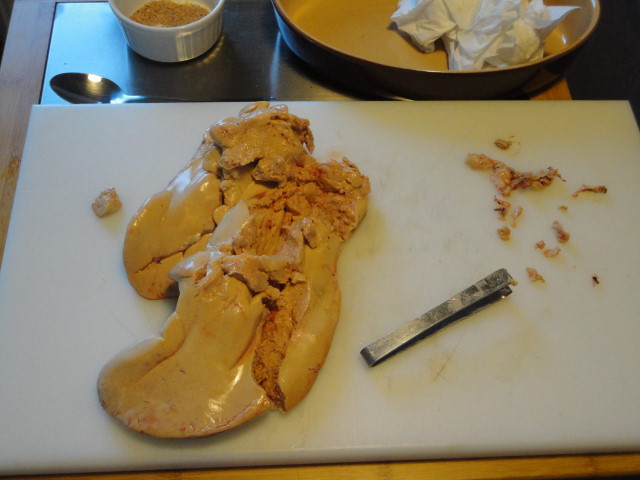
On the lookout for Foie Gras
On a Tuesday in November, the display of foie gras at the market in Orthez is an impressive sight. Not that the market at Orthez is uniquely gifted with foie gras; at this time of the year, most of the markets in the region are similarly gifted. The holiday season, from late November through the New Year, is foie gras prime time and a make or break period where producers count on making a major part of their total sales for the year.
As we hope to have friends or neighbors to the house for l’heure d’apero at several points during our stay, I am on the lookout for a nice foie gras with which to make a terrine. Nothing simplifies entertaining like having a terrine of whole foie gras in the fridge.
There are two venders ay the Orthez market selling, in all its formats, the snow white ducks raised locally and fattened for foie gras. There is fresh duck, either whole or broken into magret (the thick, steak-like breast), legs, hearts, gizzards, and various bits for the stock pot like wings, necks and the mahogany colored carcasses stripped of everything but the bones. There is also confit, primarily legs but many of the other parts as well, all tender and preserved in a layer of white fat. The fat itself is available, rendered than chilled and resembling nothing so much as a 5 gallon chunk of lemon sorbet. And there is charcuterie made from duck, including rillettes, pates, and cooked foie gras, either in bocal, can or sous-vide.
And this time of year there is also fresh liver. The elderly monsieur behind the counter at the Maison Paris stand assured me that the pale, tan colored livers had been separated from there original owners only that morning and that they had not yet been refrigerated. I like the look of one. He lets me turn it over and inspect it for bruises, bloody spots or the green discolorations that indicate the bile sack has been broken open and come in contact with the liver. As I have never seen a liver this fresh, it is hard to judge; a liver that has been refrigerated has the firm feel of good quality butter, but these are soft and pliable, with a wonderfully mild, gamey smell.
My choice, which weighs .75 kilos, cost about 24 euros, about half the price I would pay wholesale in Seattle. ‘Tis the season!
Let’s Make Terrine
The process for making terrine of whole foie gras is not very complicated and success largely depends on the quality of the liver and on following some simple steps very closely. I have detailed the process earlier and given a recipe so wont trouble you with the details. The biggest problem I had was assembling all the ingredients, as our home here is not yet fully equipped. Specifically, I had trouble finding pink (or curing) salt. Pink salt, which is a form of sodium nitrite, helps set the color of cooked meats and is helpful in the preservation of terrines, especially those that are not cooked to high temperature, as is the case with foie gras. I add a very small amount to the spice mix for my foie gras terrine if I don’t plan to use it up within the next couple days. In any event, it is fairly easy to find in Seattle through professional sausage making supply companies but where to look for it in Orthez?
The solution, of course, is to visit the local Charcutier and ask for some. After a bit of translational difficulties (a French charcuterie maker uses several different curing salt mixtures, so a bit of label reading was involved) the owner of the local charcuterie sent me on my way with a neat little half pound package and refused to accept payment, a social obligation that I later resolved by dropping by a bottle of wine.
Here are a few photos of the terrine making process.





PS The terrine turned out great (at least I was very happy with it), the liver pale pink and firm with very little loss of fat. Along with fantastic flavor and texture, a liver that doesn’t render a lot of fat is a mark of quality.
Wish we could be there for l’heure d’apero! Bon appétit!
will you bring some back to Pichet??
I cant do that (I am afraid the beagles at the airport will find them) but we will be making foie gras terrine at Le Pichet for the holidays…Should be ready around mid December.